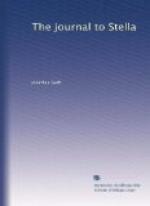This letter has been quoted at some length because of its great importance. It is obviously capable of various interpretations, and some, like Dr. Johnson, have concluded that Swift was resolved to keep Stella in his power, and therefore prevented an advantageous match by making unreasonable demands. I cannot see any ground for this interpretation, though it is probable that Tisdall’s appearance as a suitor was sufficiently annoying. There is no evidence that Stella viewed Tisdall’s proposal with any favour, unless it can be held to be furnished by Swift’s belief that the town thought—rightly or wrongly—that there was an engagement. In any case, there could be no mistake in future with regard to Swift’s attitude towards Stella. She was dearer to him than anyone else, and his feeling for her would not change, but for marriage he had neither fortune nor humour. Tisdall consoled himself by marrying another lady two years afterwards; and though for a long time Swift entertained for him feelings of dislike, in later life their relations improved, and Tisdall was one of the witnesses to Swift’s will.
The Tale of a Tub was published in 1704, and Swift was soon in constant intercourse with Addison and the other wits. While he was in England in 1705, Stella and Mrs. Dingley made a short visit to London. This and a similar visit in 1708 are the only occasions on which Stella is known to have left Ireland after taking up her residence in that country. Swift’s influence over women was always very striking. Most of the toasts of the day were his friends, and he insisted that any lady of wit and quality who desired his acquaintance should make the first advances. This, he says—writing in 1730— had been an established rule for over twenty years. In 1708 a dispute on this question with one toast, Mrs. Long, was referred for settlement to Ginckel Vanhomrigh, the son of the house where it was proposed that the meeting should take place; and by the decision—which was in Swift’s favour—“Mrs. Vanhomrigh and her fair daughter Hessy” were forbidden to aid Mrs. Long in her disobedience for the future. This is the first that we hear of Hester or Esther Vanhomrigh, who was afterwards to




